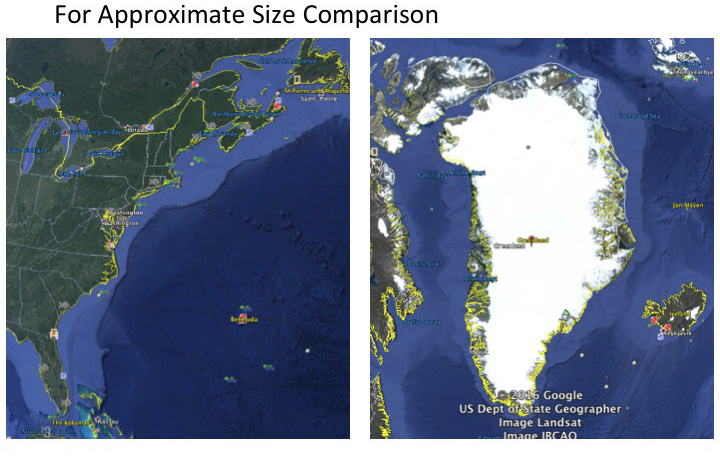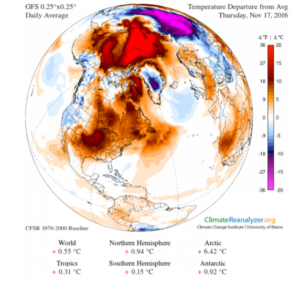Sirius Dog Sled Patrol has a Serious Problem

Sirius Dog Sled Team Stuck at Base in Greenland due to extraordinary warm weather. This is the military patrol of the vast northern perimeter.
Greenland’s military dog sled teams should have started their patrols on November 1, but a full month later, the snow and ice conditions kept them at their base camp. It has not been cold enough, yet another sign of global warming, or climate change.
Greenland is HUGE — comparable in size to the United States east of the Mississippi River as shown on the map comparison below. More than 80% of the island remains covered in an ice sheet year round that averages more than a mile deep. There are no major roads. Access to the dozen of coastal communities is by boat, airplane, dogsled or snowmobile.
The Sirius Dog Sled Patrol is the elite military unit that patrols the remote huge northeast section of the island. It was organized in1941 and is now part of the Joint Arctic Command, the Greenland-Denmark military force for the island. There are six two-man teams, each with about a dozen dogs. A primary purpose is to maintain national sovereignty, but also to provide a military and police presence for the remote communities. Perhaps surprising, interested parties are looking at strategic and natural resources in this vast territory, despite the hostile remote environment. For starters, the rare earth minerals required for much our modern electronics are found there in quantities estimated to be second only to China.
A few days ago, I had a message from Major General Kim Jørgensen, who heads the Joint Arctic Command there. He told me that the winter Sirius patrol was still at base camp — a full month late. The ice was not yet firm enough for the dog sleds. It would be extremely dangerous for the teams to be out with the ice in the fjords not having sufficient thickness. In some places normally frozen areas are still open water. It is another sign of the warming Arctic, part of our changing climate. This has continued the trend of the last few years and is very disturbing piece of the puzzle of the melting Arctic.
The Inuit — the native people of the region (akin to Eskimos) have been there for centuries. On my visits to Greenland in late August and just days before Thanksgiving, they told me they have never seen anything like this weather. They even have a word, uggianaqtuq (OOG-e-ah-nak-tuk), which translates as weather behaving unexpectedly, in an unnatural way. It is a phrase used rather frequently in recent years.
This highly unusual situation that the natives and the Sirius dog sled leaders confront, is reinforced by the image below published in the Washington Post on November 17. The color scheme shows deviations from normal. Some areas in the Greenland interior are actually below normal by a few degrees, but the perimeter is much warmer than normal. On the day depicted, North of Greenland, the Arctic Ocean shown in red, was 36 degrees Fahrenheit (20 degrees Celsius) above normal.
As readers of this blog or my book (“High Tide On Main Street“) will appreciate, it is the melting of ice on Greenland, Antarctica that accounts for about 98% of potential sea level rise. The other few percent will come from the other glaciers from Alaska to the Alps, etc. and from thermal expansion of seawater.
Looking back to my headline, the inability for the military to do their patrol is a problem, but to say it is a serious problem is perhaps a matter of perspective. Regardless, the unprecedented warm temperatures in the High Arctic should be a signal heard around the world of serious problems to come for all of us. As I said in a blog post a few months ago, “What Happens in Greenland Doesn’t Stay in Greenland.”
For Greenland, abnormal warm temperature means melting — not entirely bad news as they will get usable land back that has been covered for millennia by mile-thick ice. For the rest of us, the melting of Greenland means rising sea level and changing weather patterns. In that context, we are the ones with the serious problem.


